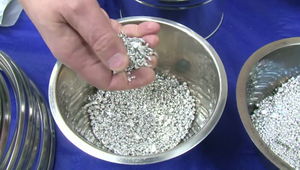Iridium
 Iridium metal granules in the hands of prof. Martyn Poliakoff | |||||
| General properties | |||||
|---|---|---|---|---|---|
| Name, symbol | Iridium, Ir | ||||
| Appearance | Silvery shiny metal | ||||
| Iridium in the periodic table | |||||
| |||||
| Atomic number | 77 | ||||
| Standard atomic weight (Ar) | 192.217(3) | ||||
| Group, block | , d-block | ||||
| Period | period 6 | ||||
| Electron configuration | [Xe] 4f14 5d7 6s2 | ||||
per shell | 2, 8, 18, 32, 15, 2 | ||||
| Physical properties | |||||
| Silvery-white | |||||
| Phase | Solid | ||||
| Melting point | 2719 K (2446 °C, 4435 °F) | ||||
| Boiling point | 4403 K (4130 °C, 7466 °F) | ||||
| Density near r.t. | 22.56 g/cm3 | ||||
| when liquid, at | 19 g/cm3 | ||||
| Heat of fusion | 41.12 kJ/mol | ||||
| Heat of | 564 kJ/mol | ||||
| Molar heat capacity | 25.1 J/(mol·K) | ||||
| pressure | |||||
| Atomic properties | |||||
| Oxidation states | −3, −1, 0, 1, 2, 3, 4, 5, 6, 7, 8, 9 | ||||
| Electronegativity | Pauling scale: 2.20 | ||||
| energies |
1st: 880 kJ/mol 2nd: 1600 kJ/mol | ||||
| Atomic radius | empirical: 136 pm | ||||
| Covalent radius | 141±6 pm | ||||
| Miscellanea | |||||
| Crystal structure | Face-centered cubic (fcc) | ||||
| Speed of sound thin rod | 4825 m/s (at 20 °C) | ||||
| Thermal expansion | 6.4 µm/(m·K) | ||||
| Thermal conductivity | 147 W/(m·K) | ||||
| Electrical resistivity | 4.71·10-8 Ω·m (at 20 °C) | ||||
| Magnetic ordering | Paramagnetic | ||||
| Young's modulus | 528 GPa | ||||
| Shear modulus | 210 GPa | ||||
| Bulk modulus | 320 GPa | ||||
| Poisson ratio | 0.26 | ||||
| Mohs hardness | 6.5 | ||||
| Vickers hardness | 1760–2200 MPa | ||||
| Brinell hardness | 1670 MPa | ||||
| CAS Registry Number | 7439-88-5 | ||||
| Discovery and first isolation | Smithson Tennant (1803) | ||||
Iridium is the chemical element with symbol Ir and atomic number 77. It is a transitional group metal, part of the so called platinum group metals. Iridium is one of the rarest elements in the Earth's crust, with annual production and consumption of only three metric tonnes, making it an expensive metal. However, despite the fact that iridium is rarer than platinum and gold, it is somewhat cheaper due to peculiarities of the precious metal market.
Contents
[hide]Properties
Chemical
Iridium is the most corrosion resistant metal, even at high temperatures. At standard conditions, no chemical compound can attack it in bulk form. Finely divided however, it is more reactive. At high temperatures, molten sodium cyanide and potassium cyanide will attack iridium, as well as oxygen and fluorine.
Iridium tends to form mixed-valence compounds, most notably iridum(IV) chloride (whose name is particularly unusual).
Iridium will form alloys with metals, such as osmium (osmiridium) and iron.
Iridium's organometallic chemistry is extensively studied, as iridium forms very stable bonds with carbon.
Physical
Iridium is a silvery white, very hard metal. It has excellent mechanical properties, which makes it difficult to work with. It's high melting point of 2446 °C makes it difficult to melt and cast, so powdered metallurgy is usually employed. It is the only metal to maintain good mechanical properties in air at temperatures above 1600 °C, making it useful as a high temperature catalyst. It is the second densest element after osmium, with a value of 22.56 g/cm3. Because of this property, most of the elemental iridium has sunk in the Earth crust.
Availability
In nature it usually found together with osmium, usually in meteorites. However due to the low concentration of Ir in meteorites and rarity of intact meteorites in nature, space rocks are not a particularly good source for the amateur chemist.
Iridium can be found in certain high-performance car spark plugs, in the tip of the electric contact. Because it's immune to most corrosive substances, it's recommended to dissolve the welding around the iridium, with a strong acid. It is not much, but being very dense, just a few spark tips can build up a significant quantity.
Lastly, iridium can be bought as bullions and coins, though in recent years its price has risen to 46 $/gram.
Iridium's high melting point and chemical resistance allows it to be used in the creation of high-performance crucibles which, unlike the ceramic ones, are very thin, thus reducing the amount of iridium used. Such crucibles are widely used for single crystal growth.
Preparation
As it sits at the bottom of the metal reactivity series, it can be reduced very easy from it's compounds.
Projects
- Organoiridium compounds
- Single crystal growth in iridium crucibles
Handling
Safety
Being the least reactive metal, iridium is non-toxic. Finely divided iridium powder can be hazardous to handle, as it is an irritant and may ignite in air.
Storage
Bulk iridium does not require any special storage. Powdered iridium should be stored in closed containers.
Disposal
Due to iridium's rarity and price, it's best to recycle it.